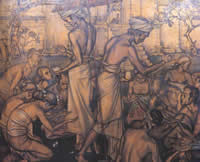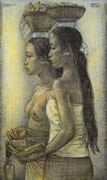Important people in Bali: Rudolf Bonnet
 Rudolf Bonnet was one of Bali’s most influential foreign artists. During his time in Bali, Bonnet was well connected with other leading foreign artists such as Walter Spies, Balinese royalty including Tjokorda Gede Agung Sukawati and helped to create the Pita Maha Artists Association as well as Museum Puri Lukisan.
Rudolf Bonnet was one of Bali’s most influential foreign artists. During his time in Bali, Bonnet was well connected with other leading foreign artists such as Walter Spies, Balinese royalty including Tjokorda Gede Agung Sukawati and helped to create the Pita Maha Artists Association as well as Museum Puri Lukisan.
•Early history
Johan Rudolf Bonnet was born on 30 March 1895 in Holland. He studied at the Rijksacademie van Beeldende Kunsten in Amsterdam, specializing in drawing and painting in the academic tradition of the early 20th century. In 1920, he left Holland for Italy, where he would spend the best part of the next eight years, mostly in the village of Anticoli Corrado near Rome. It was in Italy too that he first heard of Bali from W.O.J. Nieuwenkamp, the artist-illustrator of the island’s culture, who first visited Bali in 1904, documenting the island’s landscapes, temples, buildings, ceremonies, artifacts, and people.
•Moving to Bali: Walter Spies, Tjokorda Gede Agung Sukawati
A family visit to the Dutch Indies on the S.S. Jan Pieterszoon Coen, gave Bonnet his first experience of what is now Indonesia. Once in Java, however, the memory of the photographs Nieuwenkamp had shown him in Italy drew him further east, and he decided to visit Bali, arriving there at the end of January 1929. He was fascinated by the Balinese dance and pageantry and so decided to stay. After two months in Tampaksiring he moved to Peliatan to a pavilion rented from the punggawa of Peliatan, through whom Bonnet was introduced to all the right people in the area, in particular Walter Spies and the princes of the House of Ubud like Tjokorda Gede Agung Sukawati and Tjokorda Raka Sukawati. Friendship was immediate, and when Spies moved to a new house in Campuhan, Bonnet took over his water palace in Ubud and set up his studio there.
•Pita Maha Arts Movement
The Pita Maha Arts Movement lasted for 6 years and boasted a membership of 150. The group met at Spies’s Campuhan house, to review by the members, which included painters, sculptors and carvers. One of the directions the Pita Maha Arts Movement wanted to go in, was self expression by the artist, as well as exploring everyday themes, rather than just repeating mythical themes. The Pita Maha Arts Movement and it founders organized art displays around the world, trying to sell the best examples of the new modern Bali art styles.
Rudolf Bonnet was a driving force in the modern Balinese art scene. In 1936, he and Walter Spies, Gusti Nyoman Lempad and Cokorda Gede Agung Sukawati, founded the Pita Maha Arts Movement. This movement was designed to preserve the quality of Balinese art, which had seen a sharp decline, since the arrival of the first foreign tourists in the early 30’s.
•Japenese internment
When the Japanese landed in Bali, Bonnet was not immediately imprisoned, but his freedom did not last long. When a new officer took charge, he had the Dutchmen arrested and shipped to Sulawesi in 1943. Bonnet thus spent the rest of the war in internment camps in different places, in Paréparé, Bolong and finally in Makassar.
•Post WWII: Golongan Pelukis Ubud
 In 1947 Bonnet came back to Ubud after a short stay in Makassar. Some of the important Dutch community of the Indies had disappeared in the turmoil of the war, but those who escaped intended to stay. Bonnet, among them, had not other idea than resuming his pre-war action. In 1948, even though some Balinese artists had taken to the mountains and the conditions were far from secure, he held in Denpasar the first post-war Balinese exhibition under the auspices of the Republik Indonesia Timur. It was during this post-war period that Bonnet’s influence reached its peak. With Bonnet in Ubud, and Ubud back on the map of tourism, the reasons, which had led to the creation of Pita Maha Artists Association before the war, were still present. In 1951 Bonnet attempted to create an association with similar purposes, called the Golongan Pelukis Ubud. This organization was more limited in scope and only involved artists from the Ubud area, around the figures of I Gusti Nyoman Lempad and Anak Agung Gede Sobrat. The Golongan Pelukis Ubud, though failed to achieve durable success to recreate the equivalent of Pita Maha’s.
In 1947 Bonnet came back to Ubud after a short stay in Makassar. Some of the important Dutch community of the Indies had disappeared in the turmoil of the war, but those who escaped intended to stay. Bonnet, among them, had not other idea than resuming his pre-war action. In 1948, even though some Balinese artists had taken to the mountains and the conditions were far from secure, he held in Denpasar the first post-war Balinese exhibition under the auspices of the Republik Indonesia Timur. It was during this post-war period that Bonnet’s influence reached its peak. With Bonnet in Ubud, and Ubud back on the map of tourism, the reasons, which had led to the creation of Pita Maha Artists Association before the war, were still present. In 1951 Bonnet attempted to create an association with similar purposes, called the Golongan Pelukis Ubud. This organization was more limited in scope and only involved artists from the Ubud area, around the figures of I Gusti Nyoman Lempad and Anak Agung Gede Sobrat. The Golongan Pelukis Ubud, though failed to achieve durable success to recreate the equivalent of Pita Maha’s.
•Soekarno & Bonnet
President Soekarno turned the island into the window of Indonesia and had a palace built for himself in Tampaksiring, overlooking the Balinese nymphs at bath. Bonnet knew Soekarno, who used to visit him in his studio and had a close contact with him, dating back from an exhibition in Jakarta in 1951, when the President ordered Bonnets paintings to his palace.
•Museum Puri Lukisan
 Bonnet spent much of his time and energy dealing with the legacy of the Pita Maha years: collecting and researching the works, looking for funds for what was to be the Museum Puri Lukisan in Ubud, planning its construction, making its inventory, preparing its catalogue, etc. He remained for this purpose in constant contact with Tjokorda Gede Agung Sukawati, who tried several times to have him come back to the island. The conditions did not allow it before 1972, when Bonnet could finally come with a three-month grant from the Dutch government to make an inventory of the museum and complete its catalogue. He returned the following years (1973-1975-1976) with a similar purpose and literally set up the collection of the Museum Puri Lukisan. Meanwhile his action gained an increase in recognition, earning him awards and medals and a mythical image with the Balinese. Burdened by age and illness, he could never complete the catalogue. He passed peacefully away in Laren, Holland in 1978. It is in Bali, though, that his soul was released, when in 1979 accompanied his friend Tjokorda Gede Agung to the realm of the gods in one of the greatest cremation ceremonies to date.
Bonnet spent much of his time and energy dealing with the legacy of the Pita Maha years: collecting and researching the works, looking for funds for what was to be the Museum Puri Lukisan in Ubud, planning its construction, making its inventory, preparing its catalogue, etc. He remained for this purpose in constant contact with Tjokorda Gede Agung Sukawati, who tried several times to have him come back to the island. The conditions did not allow it before 1972, when Bonnet could finally come with a three-month grant from the Dutch government to make an inventory of the museum and complete its catalogue. He returned the following years (1973-1975-1976) with a similar purpose and literally set up the collection of the Museum Puri Lukisan. Meanwhile his action gained an increase in recognition, earning him awards and medals and a mythical image with the Balinese. Burdened by age and illness, he could never complete the catalogue. He passed peacefully away in Laren, Holland in 1978. It is in Bali, though, that his soul was released, when in 1979 accompanied his friend Tjokorda Gede Agung to the realm of the gods in one of the greatest cremation ceremonies to date.
As one of the founders of the Pita Maha Artists Association, Rudolf Bonnet strongly influenced Balinese artists and the evolution of Balinese painting. Rudolf Bonnet’s work can be seen in the Neka and ARMA, Puri Lukisan museums in Ubud.